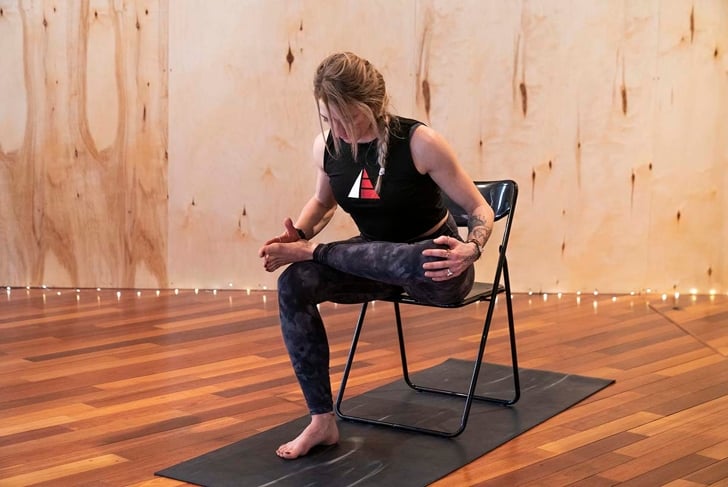
The piriformis is an important muscle in helping to rotate your hip and turn your foot and leg outward. It’s a part of the muscle group referred to as the “lateral hip rotators.” When the piriformis muscle becomes irritated, you may feel spasms and pain in your buttock region.
“Developing pain in the buttock region or down the leg is typically described as ‘piriformis syndrome’ or ‘sciatica,’ but it can also be the result of different underlying causes,” says Meghan Curle, registered physiotherapist at Evolve Physiotherapy and Collaborative Care in Whistler, BC. “It is important, if these symptoms occur suddenly or do not respond to stretches, that you talk to your doctor, physiotherapist, or other trusted health care practitioner to best understand the cause of your symptoms.”
“Often different people prefer one of the following stretches over the others based on previous injury, flexibility, or a more convenient position. Select one or two that feel comfortable for you and do them well, rather than attempt to do them all,” explains Curle.
Supine “figure-4” piriformis stretch

“[This is] a comfortable and easy go-to stretch for the hip that is often well tolerated and effective,” says Curle.
- Lying on your back with your knees bent upward, cross one leg over the other so that your ankle rests just above your knee.
- Reach behind your bent knee to grasp your thigh with both hands. Allow your head to remain relaxed on the floor. Grab your knee with one hand and your ankle with the other
- Gently pull the bent leg up and across your body until you feel a stretch in your gluteal area.
- Hold for 30 to 60 seconds and release.
Cross body piriformis stretch

“An effective but more gentle stretch that does not require twisting load through the knee,” describes Curle.
- Lying on your back with legs straight, lift one leg and bend your knee.
- With the opposite hand, gently pull your knee toward across your body and toward your shoulder.
- Hold for 15 to 30 seconds before releasing.
- Repeat 2 to 4 times with each leg.
Standing piriformis stretch

“[This is] a nice alternative for when lying on the floor is not an option or sitting is not tolerated, says Curle. “Be sure to maintain your balance to avoid falling. Consider positioning yourself near a counter or wall to have support available in case you need it.”
- Standing straight or against a wall, place one leg over the knee of your opposite leg.
- Lower your hips at a 45-degree angle and lean forward, bending the knee of the leg you’re standing on if needed.
- Keeping your spine straight, reach your arms down toward the floor as you continue to bend forward until you reach the ground.
- Hold for 30 to 60 seconds.
- Repeat the exercise on your opposite leg.
Seated “figure 4” stretch

“A simple way to fit your stretch routine into your day. A nice alternative to the lying and standing stretches,” says Curle.
- Sitting in a chair, cross one leg over the knee of your other leg.
- Keep your spine straight while bending forward to bring your chest toward your legs.
- Ensuring you feel a stretch but no pain, hold this position for 30 seconds.
- Repeat the stretch with your other leg.
Pigeon stretch for the lateral hip muscles

You’ll be sure to feel this productive stretch, though Curle cautions that “this position may not be well tolerated for individuals that have knee pain or limited hip mobility.”
- From all fours, stretch one leg out behind you.
- Bring your other leg up under your stomach so the outside of your leg is resting on the floor with your foot pointing toward the knee of your opposite leg.
- Place your forearms on the ground and lean your head forward until your forehead meets the ground, or as far as you can go comfortably.
- Keep your pelvis straight as you gently push your hips toward the floor.
- Hold for 30 seconds before returning to your hands and knees.
- Repeat 2 to 3 times on each side.
Important stretches to support recovery
“Tightness through the low back and neighboring hip muscles can influence the piriformis and gluteal muscles becoming irritated,” says Curle. “It is recommended to also regularly include low back stretches to help manage tightness or irritability in the hip.”
Child’s pose with side-bend low back stretch

“This [stretch] encourages opening through each side of the low back in a relaxed and controlled way,” explains Curle. “Easing tightness through the sides of our low back can help to ease irritation of hip muscles.”
- Kneel, then sit back onto your heels. Bend forward at the hips while reaching forward so that your forehead rests on the floor, arms are outstretched, and palms rest on the floor.
- Keeping your hips still, walk your hands to one side to create a side bend through your mid to low back.
- You should feel a mild to moderate stretch on the opposite side of the low back.
- Take 2 to 3 deep breaths, then return to the start position.
- Repeat 2 to 3 times, both directions.
Hip flexor and side-bend stretch

“Including a hip flexor stretch helps encourage hip mobility while also easing tightness through the low back,” says Curle.
- Assume a lunge position with your back knee resting on the ground.
- Stay tall through the torso while moving your pelvis forward.
- You will feel a stretch through the front of your hip and side of the leg that has the knee on the ground
- On that same side, reach upward with the arm, and reach toward the opposite side to create a slight side bend away from the kneeling leg.
- Hold for 15 seconds.
- Repeat 3 to 5 times per side.
Short adductor stretch

“This stretch not only helps to ease tightness in an important muscle group, but it also encourages hip mobility,” explains Curle.
- Sitting on the ground with the soles of your feet together in front of you, grab each ankle in the opposite hand.
- Gently push your knees toward the floor until you feel a stretch (ease off if you begin to feel any pain).
- Hold for 30 seconds and release.
Sciatic nerve flossing

This exercise works “to assist mobility of the sciatic nerve for easing irritation created from tightness of surrounding muscles,” says Curle.
- Lying on your back, bend your hip to 90 degrees.
- Grasp gently behind your thigh just above your knee and keep your head relaxed on the floor, allowing your arms to keep the leg in this position.
- Slowly straighten the knee, like kicking a soccer ball. Stop once a slight tension is felt in the back of the leg.
- Bend the ankle upwards so that the toes move toward the floor. Stop once tension is increased to a mild to moderate amount in the back of the leg.
- Allow the foot to go back to resting position, then slowly let the knee bend back to the starting position.
- Repeat 10 times
- Perform this stretch 2 to 3 times daily.
Clam

This movement “allows gentle activation of the lateral hip muscles and piriformis to encourage blood flow and mobility while encouraging activation,” explains Curle.
- Laying down on one side, bend your knees, stacking one on top of the other.
- Keeping your feet together, lift your top knee up and outward through your available movement.
- Be sure not to let your hips rotate backwards; try to keep them stacked.
- Slowly return your knee to the initial position.
- Repeat this motion 15 times on each side.




